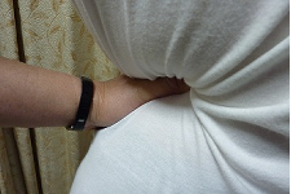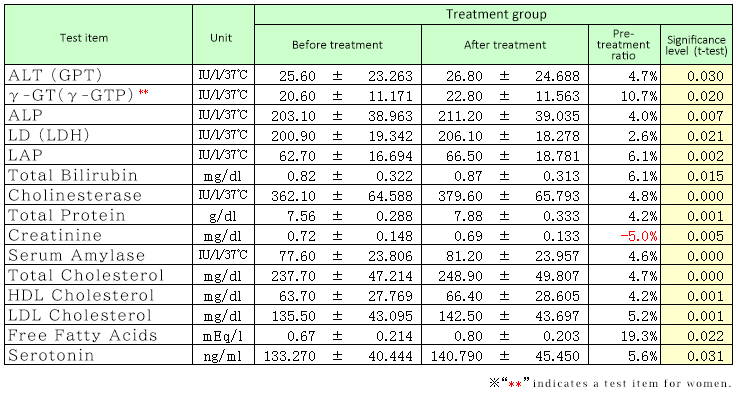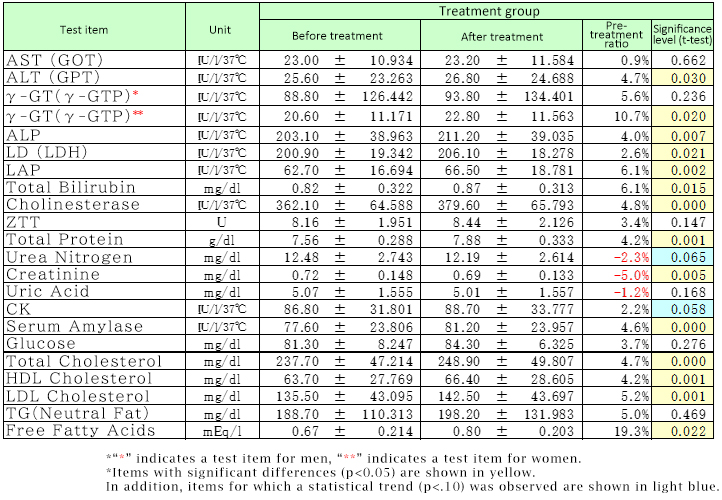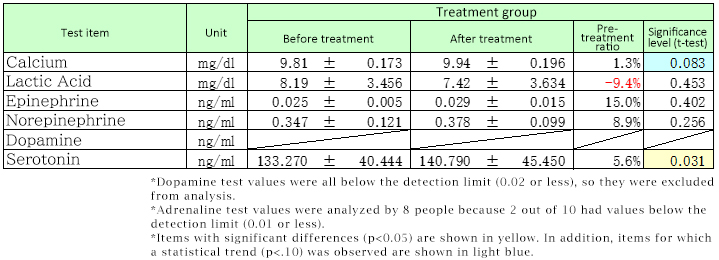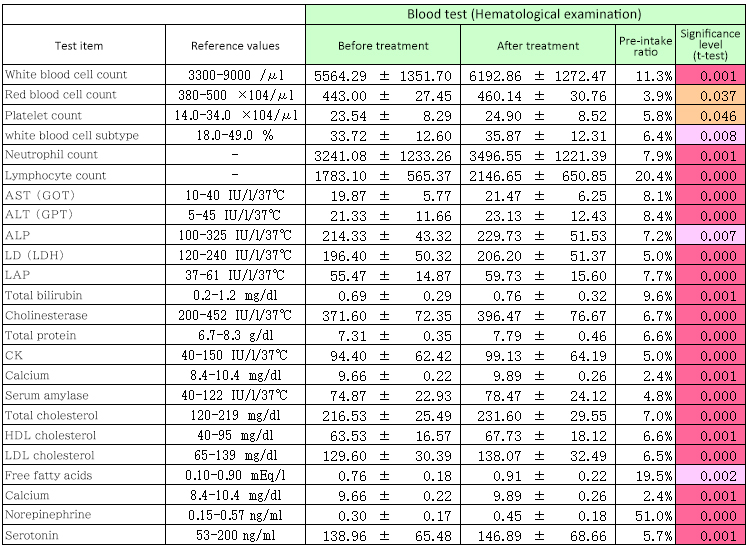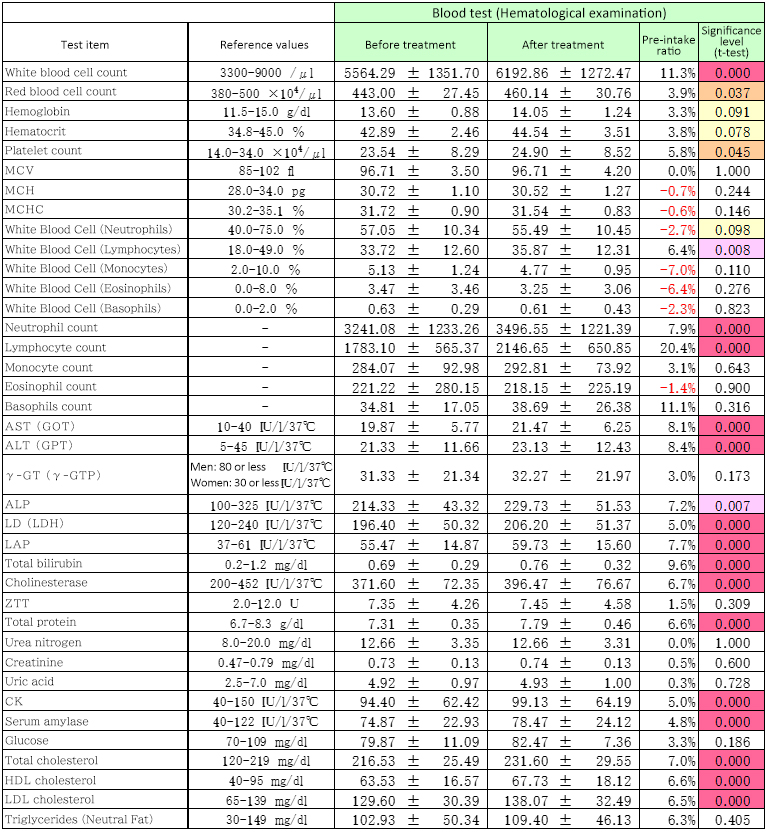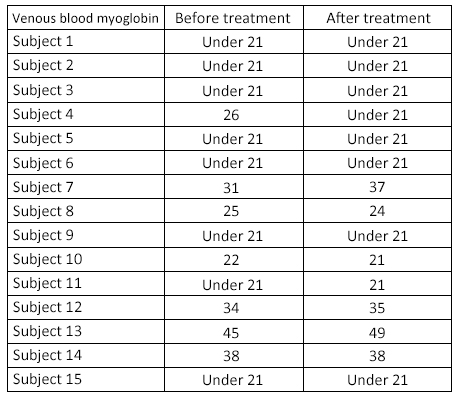Biochemistry, hormones and “kanshoho”
Explanatory Video
Relationship between biochemistry, hormones and “kanshoho”
In just 10 minutes, you will be amazed at how significantly the human body can change.
While modern humans (Homo sapiens) are believed to have appeared about 300,000 years ago, a non-invasive treatment method called “kanshoho” has emerged, which can achieve a state of “limitless muscle relaxation” without intrusion.
“kanshoho” is characterized by its immediate effect on muscle relaxation, and due to the large volume of muscles that can be relaxed even in just 10 minutes, it is also characterized by significant changes in components such as venous blood and hormone secretion.
In the study “Verification of Pain Reduction Effect by Muscle Relaxation Treatment for the Lumbar Region (1)” published in 2012, the following tests were conducted on 10 subjects:
①Blood Biochemical Tests:
1.AST (GOT)
2.ALT (GPT)
3.γ-GTP
4.ALP
5.LD (LDH)
6.LAP
7.Total Bilirubin
8.Cholinesterase
9.ZTT
10.Total Protein
11.Urea Nitrogen
12.Creatinine
13.Uric Acid
14.CK (Creatine Kinase)
15.Calcium
16.Serum Amylase
17.Glucose
18.Total Cholesterol
19.HDL Cholesterol
20.LDL Cholesterol
21.Triglycerides (Neutral Fat)
22.Free Fatty Acids
②Other Specialized Tests:
1.Catecholamine 3-Fraction (Epinephrine, Norepinephrine, Dopamine)
2.Lactic Acid
3.Serotonin
4.d-ROMs (Diacron Reactive Oxygen Metabolites)
5.BAP (Biological Antioxidant Potential)
These tests were conducted as part of the study.
The test duration was 10 minutes, and the exercise intensity during “kanshoho” treatment was approximately 2 METs. Blood samples were taken 10 minutes before the treatment and 5 minutes after the treatment. The second blood sample was collected 25 minutes after the first one.
This data pertains to each item in the “Verification of Pain Reduction Effect by Muscle Relaxation Technique (Kanshoho) Applied to the Lumbar Region (1)” study published in 2012.
Since the second blood collection was performed 25 minutes after the first, it is believed that the rate of increase or decrease in most blood components remained within a very small range, and changes exceeding 2% are considered to be attributable to the effectiveness of Kanshoho.
In the study “Verification of Pain Reduction Effect by Muscle Relaxation Treatment for the Lumbar Region (1)” published in 2012, the following tests were conducted on 10 subjects:
In “The effect of Kanshoho on low back pain (lumbago) (2)” published in 2012, the following tests were conducted on 15 participants:
①Hematological Tests: White blood cell count, red blood cell count, hemoglobin, hematocrit, platelet count, mean corpuscular volume (MCV), mean corpuscular hemoglobin (MCH), mean corpuscular hemoglobin concentration (MCHC), and white blood cell differential count (a total of 9 parameters).
②Biochemical Blood Tests: Aspartate aminotransferase (AST or GOT), Alanine aminotransferase (ALT or GPT), gamma-glutamyltransferase (γ-GTP), alkaline phosphatase (ALP), lactate dehydrogenase (LD or LDH), leucine aminopeptidase (LAP), total bilirubin, cholinesterase, zinc sulfate turbidity test (ZTT), total protein, urea nitrogen, creatinine, uric acid, creatine kinase (CK), calcium, serum amylase, glucose, total cholesterol, HDL cholesterol, LDL cholesterol, triglycerides, and free fatty acids (a total of 22 parameters).
③Special Tests: Catecholamines (adrenaline and noradrenaline), serotonin, lactate, myoglobin, and pyruvate.
These tests were conducted as part of the study.
The duration of the test was 10 minutes, and the exercise intensity during “kanshoho“ treatment was approximately 2 METs. Blood samples were collected: one before the treatment session (10 minutes before), another 5 minutes after the treatment, and a third sample was taken 25 minutes after the first blood collection.
“The effect of Kanshoho on low back pain (lumbago) (2)” identified significant changes in the following parameters. Since the second blood collection was performed 25 minutes after the first, it is believed that the rate of increase or decrease in most blood components remained within a very small range, and changes exceeding 2% are considered to be attributable to the effectiveness of Kanshoho.
In just 10 minutes, there are significant changes in so many components of venous blood.
These are the data for various parameters from “The effect of Kanshoho on low back pain (lumbago) (2),” which was published in 2012.
Above all, “kanshoho“ distinctive feature lies in its non-invasiveness and the absence of muscle damage when inducing muscle relaxation, allowing the muscles to reach an almost tension-free state. During the trials, there were instances where myoglobin levels were observed to be below the detection limit, and significant fluctuations due to the treatment were not observed, even in individuals with levels above the detection limit.
(Myoglobin detection criteria: Less than 70ng/mL, effective from October 3, 2017)
Based on the results of this study, since the changes in each parameter remained within the normal range, it is considered that there would be no adverse effects on health.
As a general interpretation for each parameter that showed significant changes,
- The increase in white blood cell count (11.3%) suggests the activation of the immune system, indicating enhanced immune responses to infections and inflammation. White blood cells are essential immune cells that protect the body from infections and inflammation, and an increase suggests that the body may be fighting against infection or inflammation.
- The increase in red blood cell count (3.9%) implies an increase in oxygen supply, indicating improved oxygen delivery to tissues and organs, suggesting improved functionality of tissues and organs.
- The increase in platelet count (5.8%) suggests improved blood clotting ability, indicating a reduced risk of bleeding and enhanced recovery from injuries.
- The increase in white blood cell subtype (lymphocytes) count (6.4%) suggests the activation of immune responses against specific pathogens, indicating an improvement in immunity against infections.
- The increase in neutrophil count (7.9%) suggests enhanced defense against infections, indicating improved immunity.
- The increase in lymphocyte count (20.4%) suggests activation of the immune system, indicating that the treatment enhances immune responses and improves defense against infections.
- The increase in AST (GOT) (8.1%) is produced in the liver and muscles, and the increase suggests activation of the liver and muscles, potentially indicating improved tissue function.
- The increase in ALT (GPT) (8.4%) is produced in the liver, and the increase suggests activation of the liver, potentially indicating improved liver function.
- LD (LDH) (5.0%): LD (Lactate Dehydrogenase) is an enzyme that reflects cellular activity, and the increase suggests cellular activation.
- The increase in LAP (Leukocyte Alkaline Phosphatase) (7.7%) suggests activation of white blood cell immune responses, indicating an improvement in immune responses through treatment. An increase in LAP values may suggest activation of the liver and biliary system, implying an enhancement in immune responses and liver-biliary tissue activity.
- The increase in total bilirubin (9.6%) suggests improved liver function, and an increase in bilirubin levels suggests a lower risk of cancer and respiratory diseases.
- The increase in cholinesterase (6.7%) suggests an impact on the normal functioning of the nervous system and implies improved liver function and lipid metabolism.
- The increase in total protein (6.6% increase) suggests an improvement in nutritional status and support for the immune system.
- The increase in CK (Creatine Kinase) (5.0% increase) suggests a potential increase in workload on muscles and the heart, but it is believed not to have a negative impact on health.
- The increase in calcium (2.4%) suggests a potential positive effect on bone health and the normal functioning of nerves and muscles.
- The increase in serum amylase (4.8%) suggests an impact of treatment on issues related to the pancreas, but it is believed not to have a negative impact on health.
- Total cholesterol (7.0%): Total cholesterol indicates the total amount of lipids in the blood, and the increase suggests changes in lipid profile but is believed not to have a negative impact on health.
- The increase in HDL cholesterol (6.6%) suggests an increase in “good cholesterol” and contributes to improved cardiovascular health.
- The increase in LDL cholesterol (6.5%) suggests an increase in “bad cholesterol,” which warrants attention for the risk of cardiovascular disease. However, it is believed not to have a negative impact on health.
- Free fatty acids (19.5%): Free fatty acids are a component of blood lipids and serve as an energy source. The increase in free fatty acids suggests an enhancement of lipid metabolism.
- The increase in norepinephrine (51.0%) suggests an impact on the central nervous system, as norepinephrine is a stress hormone. The increase implies changes in stress response and may contribute to improved concentration.
- The increase in serotonin (5.7%) suggests an impact on the central nervous system, as serotonin is involved in mood regulation. Low serotonin levels are associated with an increased risk of depression, so the increase suggests the potential to reduce the risk of depression.
In this way, “kanshoho” is characterized by its non-invasive nature and the ability to relax muscles without causing muscle damage, resulting in a state of almost complete muscle relaxation. Remarkably, significant changes can occur within the body in just 10 minutes.
Based on these results, it is believed that “kanshoho” can make a significant contribution to improving health and enhancing disease management. We strongly encourage the integration of muscle relaxation techniques like “kanshoho” into the medical field to collectively help alleviate pain and suffering for as many patients as possible.
(1) Shinichiro Yamashita et al., Verification of Pain Reduction Effect by Muscle Relaxation Technique (Kanshoho) Applied to the Lumbar Region, The 15th Japan Integrated Medicine Society, Abstracts, p118, 2012.
(2) Hirozumi sakaguchi, Takashi Sakato, Kazuo Yamamoto, Naoko Suzuki, Koji Shiizuka, Tsuyoshi Takara The effect of Kanshoho on the low back pain (lumbago) Japanese Journal of Integrative Medicine, 2012, 5(1),62-67.
